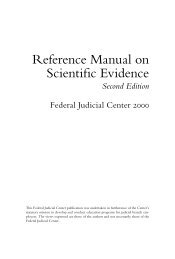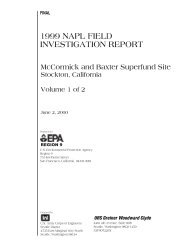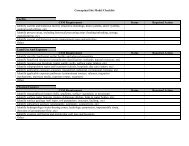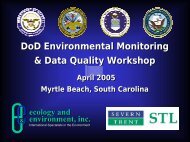Source Zone Delineation Demonstration Report - Triad Resource ...
Source Zone Delineation Demonstration Report - Triad Resource ...
Source Zone Delineation Demonstration Report - Triad Resource ...
Create successful ePaper yourself
Turn your PDF publications into a flip-book with our unique Google optimized e-Paper software.
3.3 DSITMS Soil AnalyticsDirect sampling ion trap mass spectrometry (DSITMS) introduces sample materials directly into an iontrap mass spectrometer by means of a very simple interface, such as a capillary restrictor or a polymermembrane. There is typically very little, if any, sample preparation and no chromatographic separation ofthe sample constituents. This means that the response of the instrument to the analytes or contaminants ina sample is nearly instantaneous and analyses are typically completed in less than five minutes.Soil samples collected using the Wireline CPT soil sampler and sub-sampled using EPA Method 5035were analyzed for TCE, PCE, DCE, and vinyl chloride using DSITMS according to US EPA Method8265. Samples were collected using either distilled water or methanol (MeOH) as an extractant.Approximately 10 grams of soil was extracted with approximately 30 milliliters of distilled water or 10milliliters of MeOH. The DSITMS was initially calibrated over the range of 0 g/L to 250 g/L in waterusing the 40-ml vial purge interface using a standard stock solution of TCE. This aqueous calibrationrange corresponded to approximately 8 g/kg to 1,000 g/kg when soil slurry analyses were performedon 10-gram soil samples. Subsequent calibrations were based on the soil concentrations observed inprevious samples and the required extractant utilized.Soil slurry samples were analyzed using the calibrated DSITMS system. Soil concentrations werecalculated based on the aqueous concentration measured and the soil mass used during the extraction.Each sample analysis required approximately 3 minutes to perform. Normal quality control procedureswere followed to insure the DSITMS system was operating within acceptable control limits during alldata collection activities. Following the initial DSITMS system calibration, an external performanceevaluation check (PEC) standard was analyzed to insure the calibration was accurate and contained nobias. Normal operating procedures required a minimum of one PEC analysis per day, but multiple PECanalyses generally were performed daily.System blanks and continuing calibration check standards were analyzed at a rate of at least one each forevery 20 field sample analyses performed. In addition, at least one field duplicate and matrix spikeanalysis were performed for every 20 field-sample analyses performed. Additional blank and calibrationcheck standard analyses, beyond the minimum required were performed at the operator’s discretion,based on instrument performance and the requirements of the field decisions based on the data. Forexample, blanks were always analyzed immediately after analysis of very high-level field samples toinsure that no sample carry over occurred during subsequent analyses. One significant advantage of theDSITMS and the 3-minute VOC analysis is that the analyst is able to adapt in real time to the QAdemands of the project as the data are collected. This allows the analyst to run blank analyses after anyhigh concentration samples to insure there is no carry over between soil sample analyses. It also allowsthe adjustment of matrix spike and continuing calibration check sample concentrations to reflect thosecurrently being measured in the site soil samples.During the Wireline CPT demonstration, 599 discrete soil samples were analyzed in nine working daysfor TCE, PCE, DCE, and vinyl chloride. Project reporting limits for TCE, PCE, DCE, and vinyl chlorideMarch 2003 3-6 OU 12 <strong>Demonstration</strong> <strong>Report</strong>Final










